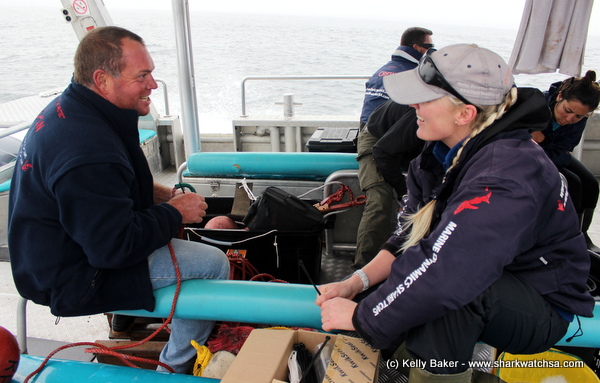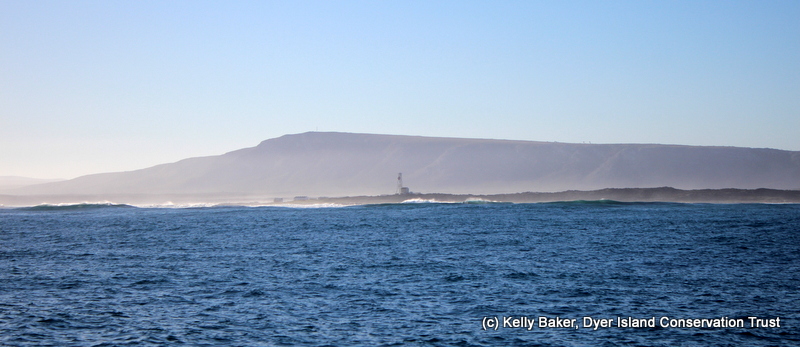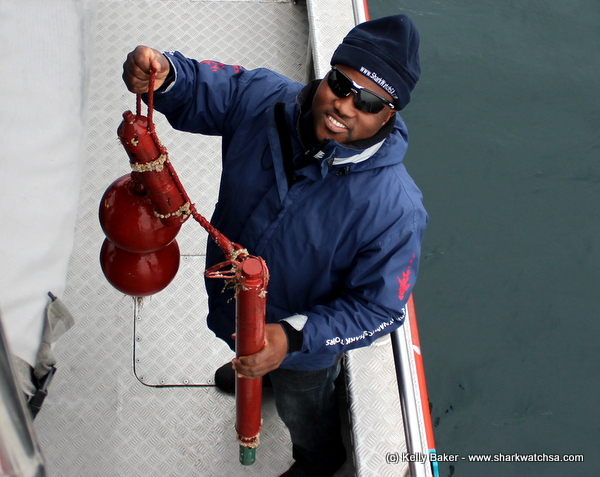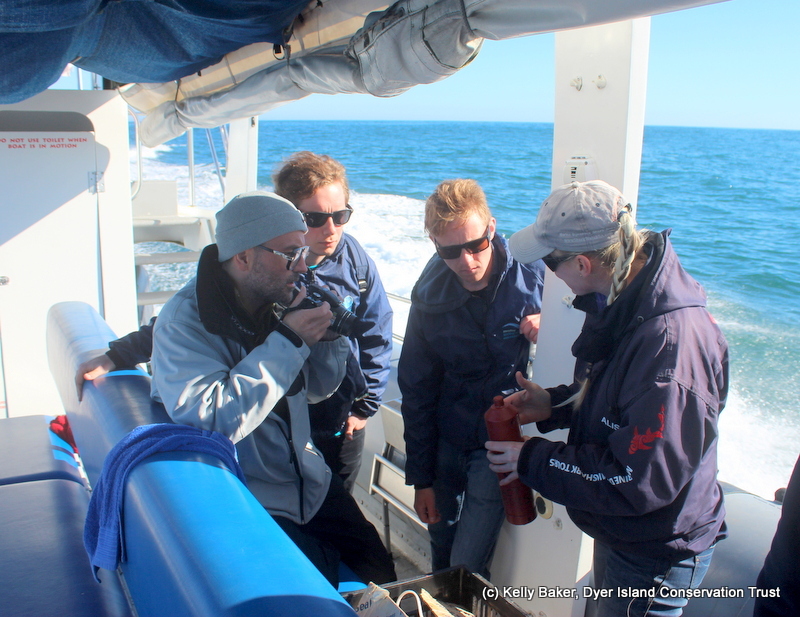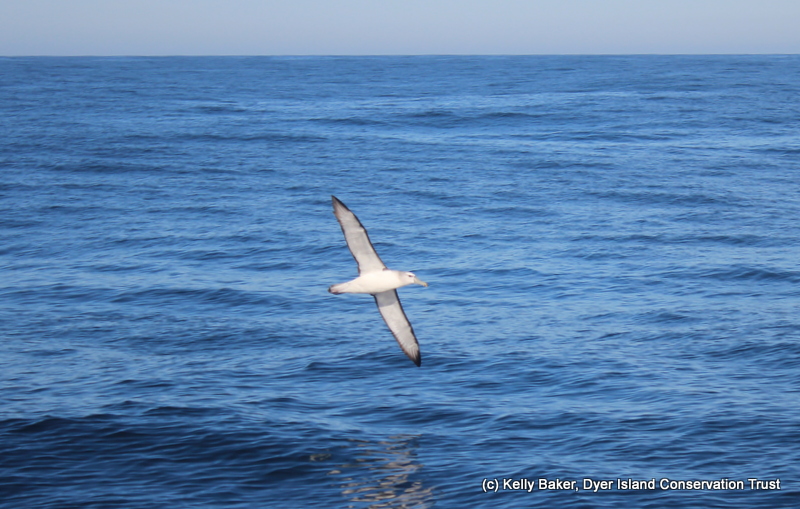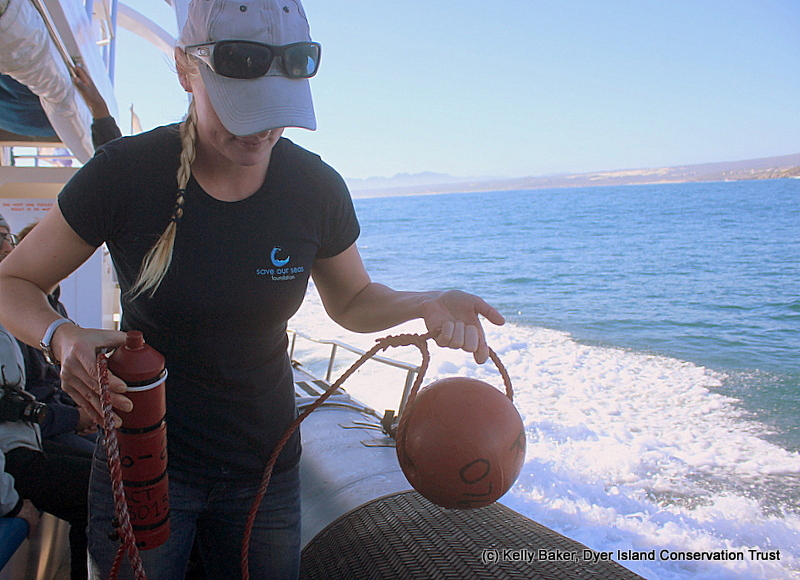Deployment success!

We began the expedition by retrieving and replacing the line of receivers previously deployed outside Dyer Island. Dr Rhett Bennett from the South African Institute of Aquatic Biodiversity (SAIAB) joined us, and as the receivers each have acoustic releases no diving was required. (Also see Dyer Island Acoustic Receiver Roll Over, DICT Deploy Vemco VR2 Listening Stations). Each ATAP listening station surfaced within 6 minutes, with very little bio-fouling. We were lucky as the process can take hours and stations can sometimes become severely fouled! We were able to re-deploy new stations again within an hour! Once completed, we moved off to several other sites around Gansbaai and Dyer Island to drop the first phase of receivers for the white shark passive tracking project. Each deployment site was carefully selected, to provide optimal acoustic tag coverage, based on our previous manual tracking data and our combined skippers extensive knowledge of white shark hotspots. It is also imperative that we selected safe depths for the receivers, given the relentless nature of the Cape of Storms!
On Saturday the 20th of June, the second phase of this project took place. The afternoon provided perfect windless conditions as the crew and I launched Whale whisperer to deploy the rest of the receivers further afield in the peripheral areas of Walker Bay, Danger and Quoin Point. The weather made for some beautiful conditions and our team were treated to sightings of humpback whales tail slapping in the sun! Albatross circled and elegantly soared passed Whale Whisperer showing off their impressive wingspans. Wilfred Chivell joined this second expedition, and our volunteers really enjoyed the information he shared with us while we sat offshore of Quoin Point.
Quoin Point, is the second most southern point in Africa, after Cape Aghulas, and has several shipwrecks strewn off its assortment of veracious reefs, including; the Johanna (1682), The Nicobar (1783), the Doncaster (1836) the Teuten (1881) the Avala (1938), the City Of Lincoln (1946) and the Esso Wheeling (1948). Wilfred talked of his amazing experience salvaging the Nicobar, a Danish shipwreck himself and Louis Groenewald found in 1987, whilst free diving. It turned out to be the largest finding of Swedish copper plate currency in the world, and took over four years to complete! Quoin Point is also a known white shark hotspot with a small cape fur seal colony. This location forms an essential part of my White shark passive tracking study. Wilfred spoke of the ‘old shark hunting’ which occurred off Quoin point, before the Second World War. White sharks were specifically targeted for their large oily livers, apparently a commercially valuable source of Vitamin A at the time. After extracting the livers, the local fishermen would discard the rest of the shark, an incredibly wasteful practice, back in a time when little scientific data existed to enable effective protection of the species. Fast forward fifty years, and we have quite the contrasting scenario in Gansbaai today, as the species is nationally protected for over 20 years and its ‘worth’ shifted through eco-tourism and research.
All In all, both expeditions were a great success and we look forward to 6 months’ time when we can review the data from tagged marine species frequenting these important areas. I’m particularly interested to see how much connectivity of white sharks occurs between Gansbaai and these peripheral locations.
This project has been in the making since late 2013, and would not have been possible without the collaborative funding from DYER ISLAND CONSERVATION TRUST AND SAVE OUR SEAS FOUNDATION. I would specifically like to thank Dr Rhett Bennet, Dr Paul Cowley (SAIAB and ATAP) Sarika Singh, Darrell Anders (Oceans and Coasts) and Dr Malcolm Smale (Bayworld museum) for their knowledge and expertise on Vemco VR2W mooring designs. In particular, I would like to thank Tami Kaschke, Peter du Toit, Kira, Francois Swart, Kelly Baker, Jan du Toit, Hennie Otto, Sean Van Der Linde and Ono Keller and the rest of the Marine Dynamics, Dyer Island Cruises and Dyer Island Conservation Trust ‘family’ for the unparalleled continued support as always!
If you are looking to get up close and personal with the great white shark then Great White Shark Cage Diving in Gansbaai, and more specifically with Marine Dynamics, is a once-in-a-lifetime experience you won’t want to miss. Book and pay online with us and get a free video of your encounter with the world’s apex predator.
_1420x587_crop_80.jpg)
